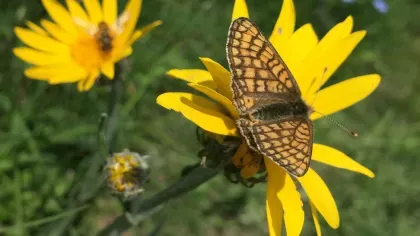Evolution of Asteraceae in the European Alps
Improving our understanding of the role of polyploidy and chromosomal rearrangements as evolutionary drivers in alpine ecosystems.

Background and overarching hypothesis
The uniqueness of the Alpine flora stems from the diversity of habitats and the harsh environments that drive species to change and adapt. Plants above the forest line, for example, have evolved different mechanisms that allow them to cope with strong winds, cold winters, short growing seasons and high UV radiation. While morphological adaptations to these conditions are well known, since they are easy to observe and interpret at the functional level, changes at the genomic level such as hybridisation, polyploidy and chromosomal rearrangements have been largely understudied.
This project aims to test the following overarching hypothesis: polyploidy and chromosomal rearrangements are key evolutionary drivers in the Alpine flora, promoting diversification, adaptation and resilience in higher altitudinal mountain ranges.
Study group and work plan
As the model system, we have selected the Asteraceae (for example sunflowers, edelweiss, daisies), one of the largest families of angiosperms, which is particularly well represented in the European Alpine flora at high altitude. We will conduct research at three different levels structured into three subprojects, each focused on a different aspect of the topic:
- Cytogenetic survey of the whole Asteraceae flora in the European Alps: Is the occurrence of polyploidy and genome size profiles throughout the alpine Asteraceae lineages linked to the environment, distribution range, habit, endemicity and/or phylogeny?
- Ploidy diversity within species: Are some cytotypes performing better at higher altitudes than others, and what predictions can be drawn on the consequences of environmental change on cytotype competition and persistence?
- Reproductive fitness and polyploidy: Do cytotypes within the same species differ in terms of the chemical composition of nectar reward, pollinator species, visit frequency and fertility?
Kew’s expertise in plant cytogenetics and genomics are essential for the success of this project to deliver critical knowledge on plant speciation in high mountain ecosystems, bringing robust evidence and new insights to the pivotal role that genomic mechanisms play in enabling adaptation to environmental stress.
This project will shed light on the large-scale and specific underlying biological processes that have occurred during the repeated colonisation of Asteraceae into the highest altitude habitats of Europe, and their potential for adaptive evolution in response to environmental change. In this sense, this project contributes to the urgent need to enhance understanding of how the alpine flora, which is at increasing risk due to global climate change, will respond and adapt. In turn, this will enable appropriate conservation strategies to be developed in this unique and diverse flora of Europe; and which may also be applicable and, hence, transferable to other systems around the world.
Objectives
- To better understand the role of polyploidy, chromosomal restructuring and other biological variables in enabling diversification in alpine ecosystems.
- To assess the evolutionary processes that shape cytotype diversity and influence plant distribution at the population level in alpine environments.
- To gain new insights into plant pollination ecology by analysing shifts in the chemical composition of nectar reward, pollinator visit frequency and fertility linked to changes in ploidy.
Team
- To build a novel comprehensive phylogenomic backbone of Asteraceae using next generation sequencing, which will serve as the framework to test our predictions.
- Obtain reference plastid genomes, which will enable a suite of molecular markers to be identified that have the potential to provide genomic data for conservation and management decisions for endangered Alpine lineages.
- Uncovering pollination performance of cytotypes – especially in populations where they coexist – will provide the opportunity to model and predict how climate change will affect community assemblages, identifying which cytotypes are favoured, and those that will be at higher risk in the face of global change.
- The large-scale analyses will provide compelling evidence of the ecological and evolutionary (chromosomal) processes and interactions driving plant speciation under high altitude environmental stress conditions.
Harding Alpine Plant and Fungal Research Programme
